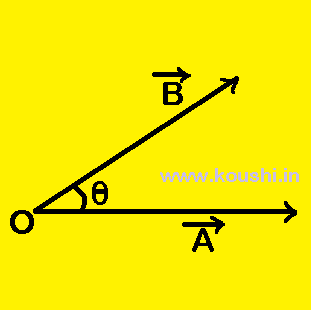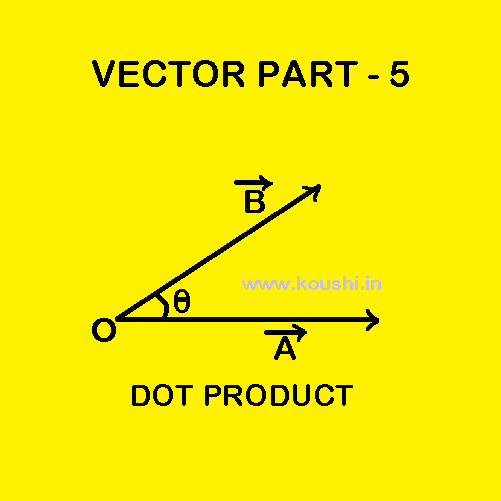Scalar product or dot product:
The scalar product of two vectors ![]() and
and ![]() is defined as the product of the magnitudes of
is defined as the product of the magnitudes of ![]() and
and ![]() and the cosine of the angle between them.
and the cosine of the angle between them.
If A and B creates angle θ then, ![]() .
.![]() = AB
= AB![]() .
.

Properties of dot product:
(i) ![]() .
.![]() = BA
= BA![]() = AB
= AB![]() =
= ![]() .
.![]()
(ii) If the angle between ![]() and
and ![]() is
is ![]() then,
then, ![]() .
.![]() = ABcos
= ABcos![]() = AB
= AB
(iii) ![]() .
.![]() = AAcos
= AAcos![]() =
= ![]()
(iv) If the angle between ![]() and
and ![]() is
is ![]() then,
then, ![]() .
.![]() = ABcos
= ABcos![]() = 0
= 0
(v) ![]() .
.![]() =
= ![]() .
.![]() =
= ![]() .
.![]() = 1.1cos
= 1.1cos![]() = 1
= 1
(vi) ![]() .
.![]() =
= ![]() .
.![]() =
= ![]() .
.![]() = 1.1cos
= 1.1cos![]() = 0
= 0
Concepts on dot product:
1. Work done: A force ![]() = (2î + 3ĵ – k̂) N is applied on a body to move it from point P (1, 2, -1) m to point Q (2, 4, 1) m. What is the work done required?
= (2î + 3ĵ – k̂) N is applied on a body to move it from point P (1, 2, -1) m to point Q (2, 4, 1) m. What is the work done required?
Force ![]() = (2î + 3ĵ – k̂) N and displacement of the body
= (2î + 3ĵ – k̂) N and displacement of the body ![]() = (2-1 ) î + (4 – 2)ĵ + (1 + 1)k̂ = (î + 2ĵ + 2k̂) m.
= (2-1 ) î + (4 – 2)ĵ + (1 + 1)k̂ = (î + 2ĵ + 2k̂) m.
Work done W = ![]() .
.![]() = (2î + 3ĵ – k̂).(î + 2ĵ + 2k̂) = 2 + 6 – 2 = 6J.
= (2î + 3ĵ – k̂).(î + 2ĵ + 2k̂) = 2 + 6 – 2 = 6J.
2. Projection: Projection of ![]() on
on ![]() or component of
or component of ![]() on
on ![]() . PQ represents the magnitude of
. PQ represents the magnitude of ![]() . PR and QS are two perpendiculars drawn on
. PR and QS are two perpendiculars drawn on ![]() and PT is parallel to RS. The component of
and PT is parallel to RS. The component of ![]() on
on ![]() is RS = PT = PQcos
is RS = PT = PQcos![]() [where
[where ![]() is the angle between
is the angle between ![]() and
and ![]() ] .
] .
= A.1.cos![]() =
= ![]() .
.![]()
EXAMPLE: What is the component of ![]() = 2î + 3ĵ + k̂ on
= 2î + 3ĵ + k̂ on ![]() = î + 2ĵ + 2k̂?
= î + 2ĵ + 2k̂?
Component of ![]() on
on ![]() =
= ![]() .
.![]() =
= ![]() =
= ![]() =
= ![]() .
.

3. Angle between two vectors: If ![]() is the angle between
is the angle between ![]() and
and ![]() then
then ![]() =
=  .
.
Example: What is the angle between ![]() = 2î + 3ĵ + k̂ and
= 2î + 3ĵ + k̂ and ![]() = î + 2ĵ – 2k̂?
= î + 2ĵ – 2k̂?
![]() =
= ![]() =
= ![]() =
= ![]() .
.
4. Perpendicular vectors: If ![]() and
and ![]() are perpendicular to each other then,
are perpendicular to each other then, ![]() .
.![]() = 0.
= 0.
Example: What is the value of n so that ![]() = 2î – 3ĵ + k̂ and
= 2î – 3ĵ + k̂ and ![]() = î + nĵ + 2k̂ are perpendicular to each other?
= î + nĵ + 2k̂ are perpendicular to each other?
Here (2î – 3ĵ + k̂).( î + nĵ + 2k̂) = 0
Or, 2 – 3n +2 = 0
![]() n =
n = ![]() .
.
